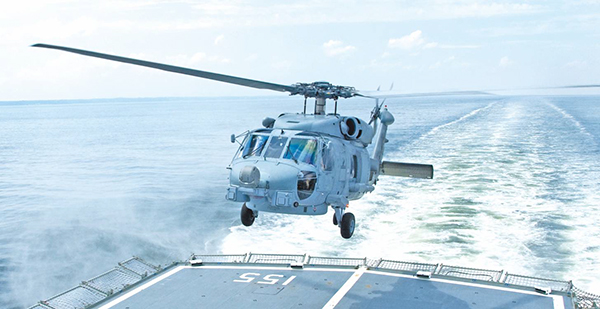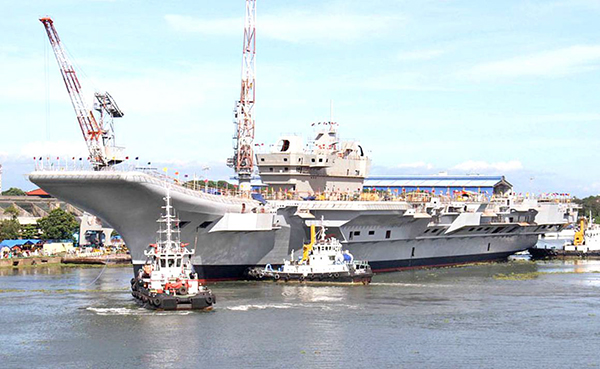The Chief of Defence Staff, Gen Bipin Rawat, who has been tasked to prioritise military procurement, said, on 17 February, that the cost could be a major factor in deciding on the issue of aircraft carriers, which were ‘very expensive’. “The Navy says its submarine fleet is dwindling. Then submarine should be our priority,” Gen Rawat said. He also said naval aviation assets could be utilised on land borders when not utilised at sea.
Hence, the Indian Navy may not get approval for a third aircraft carrier anytime soon as the priority was to bolster its submarine fleet, although on December 3, Navy Chief Admiral Karambir Singh had said that the Navy’s long-term plan was to have three aircraft carriers so that two carrier battle groups were ready for deployment in the Indian Ocean Region round-the-clock.
The Navy has been pitching for three aircraft carriers to deal with China’s growing naval prowess and its growing influence over the Indian Ocean region, a strategically key area for India.
At present, the Indian Navy has one aircraft carrier, INS Vikramaditya, which is a Russian origin platform. Indigenously built aircraft carrier (IAC) INS Vikrant is expected to be fully operational by 2022.
With several big ticket acquisitions lined up, the Navy has been undertaking fleet optimisation measures with focus on adopting unmanned platforms. However, the Navy is firm on the need for both a third aircraft carrier and the next line of six advanced submarines under Project-75I.
The Navy envisages its force structure centred around three aircraft carriers with one carrier each on the East and West coasts while one is in refit and maintenance. The proposed third carrier or the Indigenous Aircraft Carrier (IAC)-II is envisaged to displace 65,000 tonnes, conventionally powered and a steam-launched catapult for launching and recovering aircraft.
Trials of INS Vikrant
Sea trials of India’s indigenous aircraft carrier INS Vikrant have been delayed for the second time due to the Covid-19 pandemic, this time by at least six months.
The first phase of the warship’s trials – termed basin trials – was initially scheduled to begin on March 12 at Cochin Shipyard Ltd, where INS Vikrant has been constructed. However, construction delays caused that to be moved back to April.
The long-delayed warship was scheduled to be ready by the end of 2018, but due to delay in getting aviation equipment from Russia, the delivery date has been postponed. For the record, the engines onboard the first Indigenous Aircraft Carrier being constructed at Kochi have been fired up.
INS Vikrant was expected to be fully operational before the end of 2022 but the Covid-19 pandemic has already pushed that back to 2023 and further delays are possible.
The INS Vikrant is the first indigenous aircraft carrier design being undertaken by the nation of India. It is one of two planned vessels in the new “Vikrant-class” of surface warships and has seen construction begin in 2009. The Indian Navy’s first indigenous aircraft carrier Vikrant is currently under the third phase of construction.


INS Vikrant is a 260 meters long and 60 meters wide vessel displacing 37,500-tonnes. The maximum speed of the ship is announced at 28 knots, with a range of 7,500 nautical miles at a speed of 18 knots. INS Vikrant is set to receive a large crew complement composed of 160 officers and 1,400 sailors. The aircraft carrier will be able to accommodate up to 30 fighters and helicopters, including Mig-29K fighters jets and Ka-31 helicopters.
The Vikrant will be equipped with 4 x 76mm Otobreda dual-purpose cannons and backed by several surface-to-air missile emplacements. For short-ranged work against incoming aircraft or missiles, a digitally-controlled Close-In Weapon System (CIWS) will be installed. A Selex RAN-40L L-band early warning radar system will be part of the defensive network of sensor and systems processing.
Comments
The Navy envisages its force structure centred around three aircraft carriers with one carrier each on the East and West coasts while one is in refit and maintenance. The proposed third carrier or the Indigenous Aircraft Carrier (IAC)-II is envisaged to displace 65,000 tonnes, conventionally powered and a steam-launched catapult for launching and recovering aircraft.
The Navy is required to project power in the Indian Ocean Region (IOR) and locate and degrade enemy ships. It can also be accomplished by a combination of smaller ships, submarines, good information, Surveillance and Reconnaissance (ISR) and missile systems
Future war scenarios will be short and swift with limited objectives along limited axis. The Navy has seen action twice, in 1965 and 1971, on the sidelines of the land operations and the aircraft carrier had minimum role. The Karachi harbour attack in 1971 was executed by missile boats.
If all goes well, INS Vishal is expected to enter service in the early 2030s. It will operate with unarmed combat aerial vehicles as well as an fixed wing anti-submarine aircraft and medium and light fighters. It could greatly expand the mission envelope with pilot-less aircraft for high-risk reconnaissance and Suppression of Enemy Air Defenses.
MH-60R Helo Deal Signed
The US Department of Defense (DoD) announced, on 14 May, that the US Navy (USN) has awarded a $904.8 million contract to Lockheed Martin to build 24 MH-60R multirole naval helicopters for delivery to the Indian Navy (IN) under the US Foreign Military Sales (FMS) programme. The first MH-60R helicopters from the US will arrive next year.
Three of these anti-surface warfare (ASuW) and anti-submarine-warfare (ASW)-capable rotorcraft, would be delivered to the USN, while 21 platforms, costing USD791.7 million, would be handed over to the Indian government.
The IN will begin training on these first platforms in the United States before delivery of the remaining 21 rotorcraft gets under way. The work is expected to be completed by September 2024.
The MH-60R helicopters – which would replace obsolete Indian Navy Sea King helicopters, first acquired from the UK in 1971 – are meant to detect and, if necessary, engage Chinese and Pakistani submarines and warships in the Indian Ocean region.
Earlier the package announced by the US State Department in April 2019 for $2.6 billion included the cost of the choppers, their sensors and communication systems, and several weapon systems including Hellfire missiles which can targets ships, MK 54 torpedoes and precision strike rocket systems. The original package included the provision of Naval Strike Missile (NSM) developed by the Norwegian company Kongsberg Defence& Aerospace, a precursor to a potential deal for the missile system. The NSM can engage warships at a range of 185 kilometers.
Negotiations for the full package which was discussed are still underway with no closure at the moment on the exact weapons and sensor fit the IN will eventually receive with the helicopters.
For several years, the IN has been operating state of the art warships including the made-in-India Kolkata-class destroyers without any modern anti-submarine helicopters on board, the lack of which has been considered a glaring operational deficiency at a time when China has markedly stepped up its presence in the Indian Ocean region by operating a full-scale base in Djibouti in the Horn of Africa.
Sources pointed that China too had decided to invest in an aircraft carrier after it developed overall military prowess. Its force modernisation, which began in 1978, focused on military and developed capabilities to strengthen it which could settle land borders, which they have done successfully except with two nations, sources said. “They are now focusing on generating sea power and air power as they are moving towards becoming a global power.”













